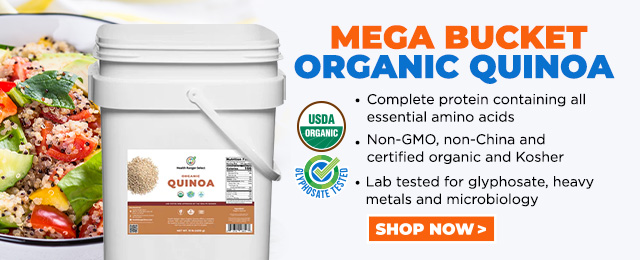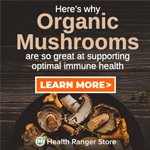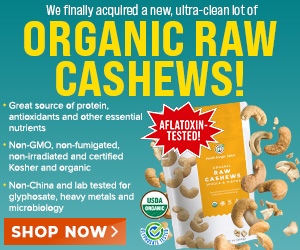
Industrial Farm Animal Production Linked to Increased Human Disease
Tuesday, February 24, 2009 by: Barbara L. Minton
Tags: animal production, health news, Natural News
- Newly released JFK files reveal Pentagon's role in creating Lyme disease and covid in the same lab
- Dr. Suzanne Humphries makes bombshell appearance on Joe Rogan podcast, exposing vaccine industry deception back to POLIOMYELITIS
- L.A.'s rebuilding nightmare: Only 4 permits issued after fire destroys 6,000 homes
- Discovery of vast underground city beneath Giza pyramids challenges human history
- Black cumin seed oil emerges as a powerful ally against breast cancer and chronic inflammation
- Catastrophic 7.7 earthquake devastates Myanmar and Thailand; death toll could reach 100,000
- AI breakthrough slashes celiac disease diagnosis time from months to minutes
- The hidden battle in your glass: How A1 and A2 milk could shape your health
- Sugar-free deception: Artificial sweeteners hijack hunger signals, fuel obesity epidemic, study warns
- Europe braces for WAR as EU urges citizens to STOCKPILE FOOD, in latest provocations with Russia
- Putin vows to 'finish off' Ukraine, accuses West of prolonging the war
- Thomas Massie’s Dual Loyalty Disclosure Act aims to restore American sovereignty by cracking down on foreign influence in Congress
- Aluminum pollution: A silent threat to human health
- Tesla owners under siege: Road rage, vandalism and political backlash fuel fear among drivers nationwide
- Chaos in Amsterdam: Five injured in broad daylight knife attack near Dam Square
- Kiss Your Genetic Privacy Good-Bye! 23andMe Gets Green Light to Sell Your Intimate Genetic Details to Anyone They Want
- "Feel G.O.O.D. Gut Health Program" on BrightU: Dr. Basima Williams introduces the Feel-Good Plate Method
- Trump's 25% auto tariffs: A bold move to strengthen U.S. manufacturing despite short-term challenges
- Newly released JFK files reveal Pentagon's role in creating Lyme disease and covid in the same lab
- Analysis: The coming economic collapse, a mass uprising and Trump's three secret weapons to halt the growing revolt
- Trump nominates VACCINE ZEALOT Susan Monarez to lead the CDC, sidelining RFK Jr.'s reform efforts
- Trump's greatest betrayal so far: Accelerating Middle East wars, silencing dissent, and serving Zionist masters
- Dr. Mike Yeadon releases 15-minute testimony - WATCH - about genocidal intent of COVID “vaccines”
- Festive flavors: The sweet history, nutritional profile and health benefits of pecan pie
- Elon Musk: Aliens could be here on Earth RIGHT NOW
- Big Pharma's $8 Billion bribery scheme exposed: how doctors are pushed to prescribe junk science, not heal
- 5 Simple steps to boost your brainpower: How to strengthen executive function in a distracted world
- Trump reverses course on Gaza plan, says “nobody is expelling Palestinians”
- A lack of integrity in Academia: Harvard professor found GUILTY of fraudulent research to promote CRT theory
- Reclaim your health: How midlife exercise reverses years of inactivity
- Survival 101: Effective EMF blocking techniques
- Florida takes a stand: DeSantis proposes permanent ban on mRNA vaccine mandates
- Sugarcane extract superior to cholesterol-lowering drugs?
- California's social media censorship law struck down: A victory for free speech or a threat to online safety?
- OpenAI whistleblower who dissented against how the company trained ChatGPT found dead
- EPA advisor admits the agency is funneling billions to climate groups ahead of Trump’s return to White House
- EPA advisor admits the agency is funneling billions to climate groups ahead of Trump’s return to White House
- Newly released JFK files reveal Pentagon's role in creating Lyme disease and covid in the same lab
- California's social media censorship law struck down: A victory for free speech or a threat to online safety?
- Dr. Mike Yeadon releases 15-minute testimony - WATCH - about genocidal intent of COVID “vaccines”
- The Health Ranger releases “Vaccine Zombie” song and music video, using AI-animated zombies for the music video
- The pandemic as a tool for INDOCTRINATION: Understanding “The Indoctrinated Brain” by Dr. Michael Nehls
- Florida takes a stand: DeSantis proposes permanent ban on mRNA vaccine mandates
- “Why we influenced the 2020 elections”: Facebook files reveal the coordinated effort to bury the Hunter Biden laptop story
- Mike Adams releases country western hit single: Goin’ Back in Time is Comin’ Home
- Mike Adams releases music poetry sensation: A Child of God
- Unpacking the Lies That We’ve Been Fed – new song and music video released by Mike Adams, the Health Ranger
- Michigan sheriff announces criminal investigation into 2020 election crimes, Dominion Voting Systems
- Migrants are taking advantage of recent hurricanes to scam residents and loot their homes
- House Intelligence Committee calls for the ARREST and PROSECUTION of Dr. Anthony Fauci
- RFK Jr. clears key hurdle: Sen. Susan Collins backs controversial HHS nominee, signaling a new era for health policy
- Rep. Nancy Mace introduces bill to ban biological males from female facilities on federal property
- Peter Rost exposes Big Pharma corruption in his book “The Whistleblower: Confessions of a Healthcare Hitman”
- Mike Adams releases new song and music video: Nothing More Disgusting Than a Globalist
- Red Cross issues warning to stop blood plasma donations from vaccinated people
- Scientists confirm: GENIUS brain function can be spontaneously unleashed in humans without any apparent cause
- EPA advisor admits the agency is funneling billions to climate groups ahead of Trump’s return to White House
- HYSSOP: What research reveals about the health benefits of this ancient holy herb
- Two containers with completed ballots fall out of truck in Florida
- Fully vaccinated about to see “tsunami” of illness and death, warns virologist
- Global leaders unite to clamp down on “misinformation” with UN-backed Cascais Declaration
- BREAKING: 2025 NDAA authorizes mandatory military draft of WOMEN across America… as Pentagon pursues global NUCLEAR war with both Russia and China at the same time
- Michael Yon warns of a ZIONIST TAKEOVER in Trump’s second administration
- BOMBSHELL: DNA testing kits are a SCAM to develop ethnic-specific bioweapons
- Ozempic and Wegovy weight loss drugs are injectable LIZARD VENOM PEPTIDES that may unleash a devastating wave of organ failure… side effects align with symptoms of SNAKE BITES
- Israeli soldiers accused of even more torture and abuse in the West Bank
- These 13 countries just signed an agreement to engineer a global FAMINE by destroying food supply
- NASA admits that climate change occurs because of changes in Earth’s solar orbit, and NOT because of SUVs and fossil fuels
- RFK Jr. clears key hurdle: Sen. Susan Collins backs controversial HHS nominee, signaling a new era for health policy
- Sermon 30: How Jesus reveals Caesar’s FAKE CURRENCY and FALSE AUTHORITY
- Coriander seeds: Ancient medicine backed by modern science
- Arizona officials claim Maricopa County needs 10-13 days to tabulate results of the election
New infectious diseases are linked to the rise of factory animal farming
Factory farms are breeding grounds for virulent disease and disease resistant strains of antibiotics, according to the 2008 report from the Pew Commission on Industrial Farm Animal Production, in conjunction with the Pew Charitable Trusts and Johns Hopkins Bloomberg School of Public Health. The commission's report highlights the risks to the public resulting from the growth of the industrialization of farm animal production. It is the result of two and one half years of investigation centered in four areas: public health, environmental impact, effects on farm communities, and animal health and welfare.
Fifteen commissioners, each with impressive credentials, concluded that while factory animal farming and production is increasing worldwide at an exponential rate, the rates of new forms of infectious diseases have been concurrently on the increase. There is clearly a link between factory farming and human illness.
Although the number of farms producing animals for food has declined dramatically in the past five decades as small independent farmers have been pushed out of the way by the giant food conglomerates, the number of food animals produced has stayed fairly constant. It is this concentration of farm animals in larger and larger numbers in ever closer proximity to one another, along with some of the feed and animal management methods used in the industrial system that has increased the risks of pathogens and created more opportunities for disease transmission to humans. Of particular concern is the increase in antibiotic use, needed to keep animals alive under such deplorable conditions. Excessive use of antibiotics has given rise to antibiotic-resistant microbes that pose a threat to the health of humans as well as animals.
The risks fall into three categories: prolonged worker contact with animals, increased pathogen transmission within a herd or flock, and the increased opportunities for the generation of antimicrobial resistant bacteria as the result of imprudent use of antibiotics, or new strains of viruses.
Communities near industrial farms animal production facilities are seen as particularly at risk, with children, the elderly, and individuals with chronic health conditions in the greatest danger of the health threats posed by such methods of farming.
Government officials ignore threat of antibiotic-resistant infections
These warnings are nothing new. Several organizations have raised questions about the effects of antibiotic use in factory farming on land and water raised animals. The Infectious Disease Society of American has declared antibiotic-resistant infections to be an epidemic sweeping through the U.S. The Food and Agriculture Organization has recommended that agricultural use of antibiotics be restricted. They claim that the health of the world's population is threatened by the globalization of industrial animal farms and concentrated animal feeding operations.
Zoonotic pathogens are on the increase
Prior to the 20th century, many humans lived short life spans relative to their potential. Many died at young ages as the result of infections. With the implementation of better hygiene and sanitation systems people began to live longer. But it wasn't until the discovery of penicillin that the life span increased dramatically. During the golden age of America that began in the early 1950s, penicillin and its derivatives kept most Americans in the picture of health. When polio was finally conquered in the 1960s, everyone believed the threat of infectious disease was history.
That golden age was short lived. New diseases began to show up at a pace previously unknown in history of medicine. A new pathogen has sprung up almost every year for the past three decades. Most of these pathogens are zoonotic, meaning they can jump the gap from animals to infection of humans. Of the documented human pathogens, about 64 percent are zoonotic.
People have turned their backs on nature in the interest of greed
According to reporter Laura Sayre in an article for Mother Earth News, the total U.S. hog population numbered 53 million in 1965. This number was spread over more than 1 million pig farms in the United States, many of which were small family operations. Today, 65 million hogs are raised on just over 65,000 farms across the nation. Many of these factory farms are raising 5,000 hogs at any given time.
Sayer notes that broiler chicken production has risen from 366 million in 1945 to 8,400 million in 2001. Most industrialized chicken raising facilities house tens of thousands of birds together. Fifty-five billion chickens are raised each year on a worldwide basis. The global pig industry is close to 1 billion, half of which are raised in confinement. Some countries house as many as 50,000 animals together.
Raising animals in such a fashion violates the principles of animal husbandry accepted as good practice by people for thousands of years and practiced on family farms. Intensive confinement often severely restricts movement and natural behaviors, such as the ability to walk or lie on natural materials, having enough floor space to move with some freedom, and rooting behaviors in pigs. The most intensive confinement systems, such as restrictive veal crates, hog gestation pens, restrictive furrowing crates, and battery cages for poultry all prevent animals from normal range of movement and are particularly inhumane treatments.
The outcome is animals in severe distress. Animals cannot be cared for by tried and true traditional methods when they are crammed together in factory farms in confined conditions. Animals raised under the industrial model experience no quality of life and live in constant stress as the result of overcrowding. This results in weakened immune systems and susceptibility to infection. Lack of sunlight and fresh air guarantees any disease will spread like wildfire.
Good animal husbandry helps protect the safety of the food supply. Scientists have recognized that food safety is linked to the health of animals that produce meat, dairy and egg products. They know that intensive confinement production systems produce increased pathogen shedding in animals.
To prevent and treat the diseases that arise from such conditions, the lords of factory animal farms have relied on antibiotics to the point of injecting chicken eggs with them. Animal feed is laced with antibiotics and so are the tissues and organs of these animals when they appear in the butcher's case. Producers of 'natural' chickens that are claimed to be free of antibiotics can get by with that claim because the chicken embryos are soaked in antibiotics while they are inside the eggs. Today, the majority of antibiotic use is preventative.
Overuse of antibiotics in people is insignificant compared to that in animals
Some members of the medical establishment and many critics outside of the medical profession have been concerned for many years about the excessive prescribing of antibiotics for diseases that offer inconvenience as their major threat. These warnings have generally fallen on deaf ears within both the medical profession and government regulatory agencies. Antibiotics are now often the first choice treatments for diseases that are not even affected by them, like the common cold.
This excessive use of antibiotics pales in comparison with their use in the industrialized raising of animals for food. According to Sayers, "it's a simple fact that the more antibiotics are used, especially prolonged use at low doses as in factory farms, the more antibiotic-resistant microbes will become. Bacteria and viruses are also notoriously promiscuous, swapping genes across species and even across genera, creating what the Johns Hopkins researchers call reservoirs of resistance. In some pathogens, selection for resistance also results in increased virulence...In other cases, otherwise harmless microbes can transfer resistance genes to pathogenic species."
Bio-containment procedures are geared toward protecting livestock from disease outbreaks. There appears to be little concern about preventing human pathogens from escaping into the wider environment through the many routes available that include the food itself, water, and air. A worker in such facilities can carry pathogens home on his body or clothing without being aware of it, allowing microbes to be released in towns or cities miles away from the factory farm where he works. Globalization means that pathogens can be spread anywhere.
Waste systems are inadequate to neutralize pathogens
Human health is further threatened by the likelihood of animals to excrete pathogenic microbes. The tremendous quantities of waste that concentrate on the premises of industrial animal producers may exceed the capacity of the landscape to absorb the nutrients and neutralize the pathogens. The annual production of manure produced by animal confinement facilities exceeds that produced by the human population of the country by at least three times. And unlike human sewage, the majority of waste from factory farms is spread upon the ground untreated.
Such large quantities of manure carry excess nutrients and chemicals including antibiotics, hormones and heavy metals into waterways, lakes, groundwater, soils and airways. Land application of untreated animal waste on cropland contributes to excessive nutrient loading, and ultimately to plant growth so dense around water that aquatic animal life is suffocated.
Greenhouse gas emissions from livestock operations account for 18% of all anthropogenic greenhouse gas emissions, exceeding emissions from the transportation sector. Air quality degradation is also a problem near industrial farm animal production because of the localized release of toxic gases, and particulates and bioaerosols that contain microorganisms including human pathogens. Livestock emission of ammonia from factory farms adds to the acidification of soil and water, while species diversity is threatened by nutrient overload.
Factory animal farms shown to be linked with food borne illness
"When dioxin-contaminated chicken feed led to the removal from the market of all chicken and eggs in Belgium for several weeks in June of 1999, doctors there noted a 40 percent decline in the number of human Campylobacter infections," according to Sayer. Most chickens sold in the U.S. are contaminated with this bacterium. Eggs from factory farm chickens contaminated with salmonella caused 2,000 hospitalizations and 60 deaths in the year 2000. A host of infections not thought of as food-related may be the result of overuse of antibiotics at factory farms.
The MRSA bacterium, responsible for difficult or impossible to treat infections in humans, seemed to come out of nowhere when it was first seen in hospitals. Now the Veterinary Microbiology study has showed that industrialized North American pig farms and farmers commonly carry MRSA, including a strain that infects humans. Around nine million Canadian raised hogs are imported into the U.S. every year.
Healthy people are developing MRSA infections. Medical, agricultural, and environmental experts have called for Congress to compel the FDA to study whether use of antibiotics in animal agriculture is contributing to the surge in MRSA deaths in the U.S., which now exceed the number of deaths from HIV/AIDS. Since the government is not systematically testing U.S. livestock for MRSA, it is not known whether farms in the U.S. are also sources.
The excessive use of antibiotics in factory farms can select for resistant bacteria, such as MRSA. A European study has documented that industrial pig farms routinely using antibiotics were more likely to have MRSA than farms with limited antibiotic use.
For more information:
http://www.pewtrusts.org/news_room_detail.as...
http://www.ens-newswire.com/ens/apr2008/2008...
http://www.motherearthnews.com/Natural-Healt...
http://www.news-medical.net/?id=32320
About the author
Barbara is a school psychologist, a published author in the area of personal finance, a breast cancer survivor using "alternative" treatments, a born existentialist, and a student of nature and all things natural.Animal production at FETCH.news
Get independent news alerts on natural cures, food lab tests, cannabis medicine, science, robotics, drones, privacy and more.
More news on animal production
Take Action: Support Natural News by linking to this article from your website
Permalink to this article:
Embed article link: (copy HTML code below):
Reprinting this article:
Non-commercial use OK, cite NaturalNews.com with clickable link.
Follow Natural News on Facebook, Twitter, Google Plus, and Pinterest
Science News & Studies
Medicine News and Information
Food News & Studies
Health News & Studies
Herbs News & Information
Pollution News & Studies
Cancer News & Studies
Climate News & Studies
Survival News & Information
Gear News & Information
News covering technology, stocks, hackers, and more



"Big Tech and mainstream media are constantly trying to silence the independent voices that dare to bring you the truth about toxic food ingredients, dangerous medications and the failed, fraudulent science of the profit-driven medical establishment.
Email is one of the best ways to make sure you stay informed, without the censorship of the tech giants (Google, Apple, Facebook, Twitter, YouTube, etc.). Stay informed and you'll even likely learn information that may help save your own life."
–The Health Ranger, Mike Adams












































